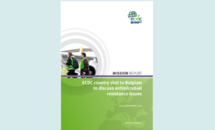ECDC country visit to Belgium to discuss antimicrobial resistance issues
An ECDC country visit team conducted an assessment mission on 20-24 November 2017 to discuss antimicrobial resistance (AMR) issues in Belgium with the overall objective to provide an observation-based assessment of the situation in Belgium regarding prevention and control of AMR through prudent use of antibiotics and infection control.
Executive summary
Rationale and purpose of the country visit
Council Recommendation of 15 November 2001 on the prudent use of antimicrobial agents in human medicine (2002/77/EC) outlines the threat that AMR poses to human health and advocates for a range of actions to be taken for its prevention and control. Council Conclusions on antimicrobial resistance (AMR) of 10 June 2008 reiterated this call for action.
To assist Member States in implementing the Council Recommendation, ECDC has developed a process for and is carrying out, upon invitation from national authorities, country visits to specifically discuss and assess the situation of the country regarding prevention and control of AMR through prudent use of antibiotics and infection control. These country visits also help document how Member States have approached this implementation and deployed national activities and support the European Commission in evaluating this implementation.
The main output of the visit is a report from the ECDC Team provided to the inviting national authority. To help the ECDC Team ensure consistency of the visits and follow-up of progress of countries, an assessment tool has been developed. The assessment tool includes ten topics. These topics are regarded as core areas for successful prevention and control of AMR and are based on Council Recommendation 2002/77/EC and on Council Conclusions of 10 June 2008. The assessment tool is used as a guide for discussions during the visit.
Following the official invitation by Mr. Tom Auwers, President of the Executive Committee, Belgian Federal Public Service Health, Food Chain Safety and Environment (FPS Health) (23 August 2017), an ECDC country visit team conducted an assessment mission on 20-24 November 2017 to discuss antimicrobial resistance (AMR) issues in Belgium with the overall objective to provide an observation-based assessment of the situation in Belgium regarding prevention and control of AMR through prudent use of antibiotics and infection control. This country visit was conducted as a joint One Health AMR country visit together with a team from the European Commission’s Directorate General for Health and Food Safety Unit F5.
Conclusions
Although the percentage of meticillin-resistant Staphylococcus aureus (MRSA) isolates over all S. aureus tested has been declining since 2003, particularly within healthcare-associated infections, Belgium now faces challenges in preventing and controlling infections with multidrug-resistant Gram-negative bacteria. For example, the percentages of ESBL-producing E. coli and K. pneumoniae have been increasing since 2007. Moreover, the latest data from EARS-Net show a substantial increase in the percentage of carbapenem-resistant isolates among K. pneumoniae from bloodstream infections. Between 2012 and 2015, active surveillance of carbapenem-producing carbapenem-resistant Enterobacteriaceae (CRE) from the National Reference Centre (NRC) demonstrated a threefold increase in the number of reported isolates. Of greater concern is the emergence of New Delhi metallo-betalactamase (NDM)-producing CRE, which increased from 0.5% in 2012 to 8% of reported carbapenemase-producing CRE in 2015. Between 2012 and 2015, the NRC provided services to all Belgian hospitals and private laboratories for carbapenemase detection. In 2015, CPE was added to the mandatory surveillance of multidrug-resistant gramnegative bacteria. Nevertheless, reporting of CPE is de facto optional, because not all hospital laboratories have the capacity to detect carbapenemase production. Reporting of CRE (without information on carbapenemase production) is compulsory for six months per year; most hospitals provide data for the full year on a voluntary basis.
Belgium was one of the first European countries to implement a national antibiotic policy coordinating commission, the Belgian Antibiotic Policy Coordination Commission (BAPCOC). The work and dedication demonstrated so far are impressive, with outstanding professionals who contribute to the ambitious targets set by the Steering Committee (‘Bureau’) and the Working Groups. BAPCOC efforts to produce evidence-based, independent guidelines on appropriate antibiotic use, in both the community and hospital settings are laudable. Moreover, BAPCOC promotes activities conducted to foster education groups, among GP circles and among hospital networks, and has also been promoting awareness campaigns for the general public for many years. These campaigns were initially successful in reducing antibiotic consumption, by reducing the demand for antibiotics, and contributed to reducing AMR in S. pneumoniae in Belgium.
Despite all these activities, human antibiotic use in Belgium remains above EU/EEA average in the community if expressed in DDD per 1 000 inhabitants per day, but falls below the EU/EEA average when expressed in packages per 1 000 inhabitants per day. In addition, a heavy emphasis is placed on prescription of broad-spectrum antibiotics both in the community and in hospitals, bestowing a higher risk that AMR will develop and ultimately increase the costs of healthcare. In addition, a significant proportion of hospitals report not having a policy to restrict the use of last-resort antibiotics. Moreover, antibiotic susceptibility is not reported selectively on laboratory results and often decisions on which antibiotics to prescribe are not supported by infectious disease specialist advice (which is particularly important in hospital settings).
National surveillance of healthcare-associated infections (HAIs) due to antimicrobial-resistant bacteria, and HAIs in general, performed by the Scientific Institute of Public Health (WIV-ISP), was considered to be one of the most extensive national systems seen during the ECDC country visits on AMR. This impressive surveillance system has contributed to documenting the successful reduction of MRSA in the country. However, surveillance is now highlighting an even bigger patient safety challenge - the increasing impact of CRE on healthcare. We believe that Belgium is at a cross-roads: the situation can still be controlled to ensure that the CRE epidemic does not reach the endemic situation similar to that in a number of southern EU countries where deaths from untreatable CRE infections are, unfortunately, a daily reality.
Belgium will need to establish its own ranking priorities. Ultimately, however, the success of AMR control will depend on increasing the level of urgency for change among all prescribers, stakeholders and the general public. In turn, this will require strong leadership and a considerable top-down direction.
Download





